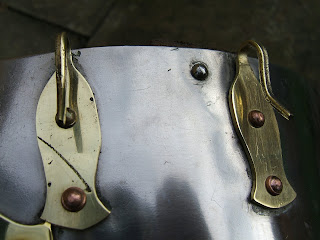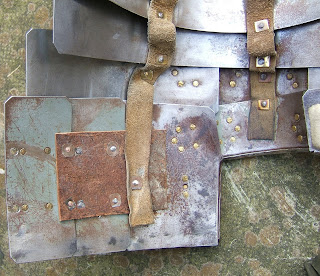
Those fans of J.R.R.T. might be interested to go here
 This photograph was taken in the churchyard of the tiny church of St Peter and St Paul, Bilsington which is on the escarpment leading down to Romney Marsh . This yew tree must be as old as the church (AD 1292). The reason it appealed to me was that Tennyson's "In Memoriam" came to mind as soon as I saw it.
This photograph was taken in the churchyard of the tiny church of St Peter and St Paul, Bilsington which is on the escarpment leading down to Romney Marsh . This yew tree must be as old as the church (AD 1292). The reason it appealed to me was that Tennyson's "In Memoriam" came to mind as soon as I saw it.
 The scabbard (vagina - pronounced "wageena" – hard "g" in Latin) was constructed by pressing out the front plate over a former. Then the design was engraved on it using modern electrical tools (you can only take re-enactment so far!) The Romans then used vitreous enamels to fill the resulting engravings. We cheat and use Araldite glue mixed with the appropriate colour paints. When it cures it is indistinguishable from enamel. The back plate is then soldered on. The hangers are crafted from brass and then rivetted through.
The scabbard (vagina - pronounced "wageena" – hard "g" in Latin) was constructed by pressing out the front plate over a former. Then the design was engraved on it using modern electrical tools (you can only take re-enactment so far!) The Romans then used vitreous enamels to fill the resulting engravings. We cheat and use Araldite glue mixed with the appropriate colour paints. When it cures it is indistinguishable from enamel. The back plate is then soldered on. The hangers are crafted from brass and then rivetted through.  My next job was to make repairs to my armour (lorica segmentata). This wears in two ways.
My next job was to make repairs to my armour (lorica segmentata). This wears in two ways.
 (broken ones are often found on Roman military sites, so we know they had the same problem).
(broken ones are often found on Roman military sites, so we know they had the same problem). The other job is to replace the leather straps which hold the armour plates together as these wear or rot with sweat. My armour needed the large square piece of leather replaced (photo shows the new piece in situ). Again – a rivetting job.
The other job is to replace the leather straps which hold the armour plates together as these wear or rot with sweat. My armour needed the large square piece of leather replaced (photo shows the new piece in situ). Again – a rivetting job.
